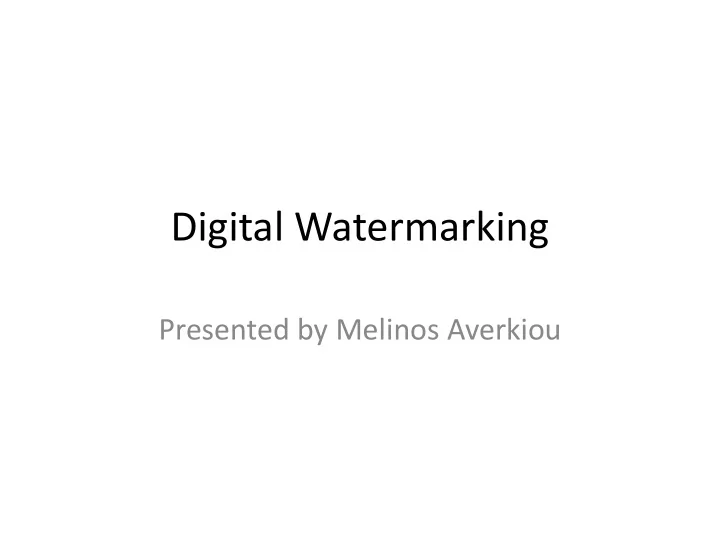

Digital Watermarking Presented by Melinos Averkiou
History • 1282 – Paper Watermarks • 1779 – Counterfeiting • 1954 – Watermarking music • 1988 – First use of the term Digital Watermark • End of 1990s – large interest in watermarking
Applications • Broadcast monitoring • Owner identification • Transaction Tracking • Content Authentication • Copy Control • ..many more
Watermarking Properties • Embedding effectiveness • Fidelity • Payload • Blind or informed detection • False positive rate • Robustness
Watermarking models 1. Communication-Based • Without side-information • With side-information
Watermarking Models 2. Geometric • Media Space – Embedding Region – Detection Region – Region of acceptable fide lity • Marking Space
Watermarking without side- information
Blind Embedding and Linear Correlation Detection Embedder: 1. Choose one random reference pattern(w r ) 2. Choose message mark for 1 and 0 α controls the embedding strength Detector: 1. Calculate linear correlation z lc 2. Detect message according to z lc
Geometric Interpretation
+ α = 1
Effectiveness 400 images (112 x 92 pixels) 15 10 No watermark m=0 m=1 Percentage of images 5 0 -3 -2 -1 0 1 2 3 Detection value
Reference pattern is very important Low pass reference pattern 16 No watermark 14 12 10 m=1 Percentage of images m=0 8 6 4 2 0 -3 -2 -1 0 1 2 3 Detection value
α is very important α = 2 14 12 10 No watermark m=1 m=0 Percentage of images 8 6 4 2 0 -3 -2 -1 0 1 2 3 Detection value
Adding noise 14 12 10 No watermark m=1 Percentage of images m=0 8 6 4 2 0 -3 -2 -1 0 1 2 3 Detection value
Watermarking with side-information
Informed Embedding and Linear Correlation Detection Embedder: 1. Choose one random reference pattern(w r ) 2. Calculate α so that we have 100% effectiveness 3. Choose message mark for 1 and 0 Detector: 1. Calculate linear correlation z lc 2. Detect message according to z lc
Geometric Interpretation
+
Effectiveness 100 90 m=1 m=0 80 70 60 Percentage of images 50 40 30 20 No watermark 10 0 -3 -2 -1 0 1 2 3 Detection Value
Adding Noise 100 90 80 70 60 Percentage of images 50 m=0 m=1 40 30 No watermark 20 10 0 -3 -2 -1 0 1 2 3 Detection value
Exploiting Marking Space
Dirty Paper Codes • One code book comprised of subcode books for each message • Select the code most similar to the original work
Block-Based/Fixed Robustness Embedding – Correlation Coefficient Detection Embedder 1. Extract a watermark vector v o by summing 8 x 8 blocks 2. Find the highest correlation between v o and a set of reference marks (one set for 1, one set for 0) 3. Embed the highest correlation mark into the image using a fixed robustness algorithm Detector 1. Extract a watermark vector v o by summing 8 x 8 blocks 2. Find the highest correlation between v o and the two sets of reference marks 3. If it’s above the threshold then the message is detected
Geometric Interpretation
Before embedding After embedding
Fidelity 18 17.5 17 MSE after embedding 16.5 16 15.5 15 0 5 10 15 20 25 30 35 40 Number of reference marks per message
Effectiveness • t nc =0.95 R 2 =30 180 160 140 120 Number of images 100 80 60 40 20 0 0.9993 0.9994 0.9995 0.9996 0.9997 0.9998 0.9999 1 Detection value
Orthogonal Lattice Dirty Paper Code Embedder 1. Encode the message into a sequence of coded bits using Trellis coding 2. Divide the image into 8 x 8 blocks 3. Modify each block to embed a bit using the reference mark Detector 1. Compute correlation of each block with the reference mark and use it to find z z= floor ( corr / α + 0.5 ) 2. If z is odd then we have a 1, else we have a 0 3. Decode the message using the Viterbi decoder
Before embedding After embedding Original message: 1024 bits Embedded message: 4096 bits MSE = 1.6927 Errors = 0
Other Methods • Frequency Domain Based – Using DCT Coefficients – Using Wavelets
Thank You!
Recommend
More recommend